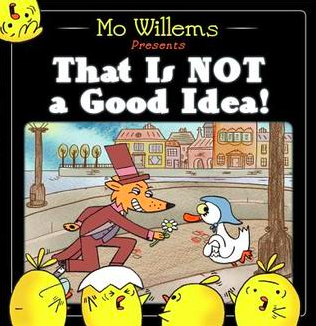That is NOT a Good Idea!
Book Module Navigation
Summary
That is NOT a Good Idea! can prompt discussions about the philosophy of humor and irony.
A fox and a goose meet while walking through town, and the predator knows just what to do. The unlikely pair makes its way back to the fox’s house, despite the frantic cries of “That is REALLY not a good idea!” from some baby geese who see right through the plan. The pair cooks up some soup, but it’s missing one ingredient. Surprise, it’s the fox! The goose traps the fox in the pot and eats the soup for dinner. The baby geese tried to warn him!
Read aloud video by The Reading Teacher with a focus on prediction in reading
Guidelines for Philosophical Discussion
Mo Willems’ That Is NOT a Good Idea! uses clever illustrations and word choice to set the reader up for a hilarious plot twist. This book will leave you chuckling, but also asking yourself, “Why did I think the story was going to end this way?”
The illustrations and dialogue are strategically laid out on the pages in a way that sets the reader to fall straight into the same trap the fox did. There is no clear indication of who is saying what, and whom the baby geese are talking about/to. Who could have assumed the sweet mother goose was the predator all along? The baby geese’s remark of “Well, we did try to warn him,” at the end of the story, just might have you feeling as foolish as the fox.
The author knew that readers would be not only surprised but also amused by this turn of events. Why did we fall for it? Why did we assume the fox was the predator, and the goose the prey? Why did we assume that the baby geese’s warnings were directed towards the mother goose? This opens up opportunities for dialogue about our assumptions and expectations. The surprise may be due to either ingrained or manufactured bias. On one hand, we know the basics of the animal kingdom, and that a goose would be the prey of a fox, never the reverse. On the other, look at the pictures in That is NOT a Good Idea! Has the illustrator’s presentation of the characters manipulated our perspective? The fox’s sinister hunger, as well as the goose’s motherly bonnet and innocent eyes, imply a very different result. Both options are worth exploration, or perhaps you may develop your own theories.
This book also provides a great chance to study the philosophy of humor. Why is the ending so funny? Maybe we laugh because we think it’s funny to see something bad happen to the fox, whom we all had considered the “bad guy.” We see this villain being deceived, and we feel a sense of superiority because it happened to him, not us. Things usually aren’t as funny when the joke is on you. In philosophy, this idea is called the Superiority Theory. It suggests that we laugh because we feel smarter than the character who got tricked. If this is the case, would we have laughed if the goose had ended up in the soup? If the fox had indeed trapped the goose, we probably wouldn’t be laughing. So why is it so funny when the roles are reversed? The death of the fox isn’t funny in itself; rather, the entire situation is humorous.
This book provides an example of type of humor known as ironic humor. There is a philosophical theory called the Incongruity Theory. It suggests that we find humor in a situation that appears vastly different than what we may have expected or what logically makes sense. In That Is NOT a Good Idea!, we expected the fox to put the goose in the soup. Foxes are natural predators of birds, so the idea of the fox ending up as the prey is funny to us. This is a good way to introduce and define the topics of logic, humor, and irony to young students.
Questions for Philosophical Discussion
Assumptions and Expectations”’
“What luck!” “Dinner!”
- Did you guess what the goose was planning before it happened?
- Were you surprised by the ending? Why?
- Most people expect the fox to trap the goose. Why is that?
- If you were the fox, would you have fallen for the goose’s trick?
- Was the fox foolish for leaning over the pot? Why or why not?
- Have you ever expected something to happen, then experienced the opposite? Why did you expect it to happen the way that it did?
- Do you think the author thought you would think the fox was the villain? Why or why not?
Humor and Irony
“Would you care to visit my nearby kitchen?”
- Did you laugh at the end of the book?
- What made the ending funny?
- Do you think the fox was laughing when the goose was trapping him? Are things funnier when they happen to someone else?
- Is it funnier when bad things happen to the bad guy, not the good guy?
- Would you have laughed if the fox had trapped the goose? Why (not)?
- We expected the fox to eat the goose, but the opposite happened. Is it always funny when something unexpected happens?
- If you expected the weather to be rainy, but it was actually sunny, would you laugh?
- Does anyone know what “irony” is? Why might we find an ironic situation funny?
Original questions and guidelines for philosophical discussion by Lauren Osur and Lily Hartley. Edited June 2020 by The Janet Prindle Institute for Ethics.
Find tips for leading a philosophical discussion on our Resources page.






